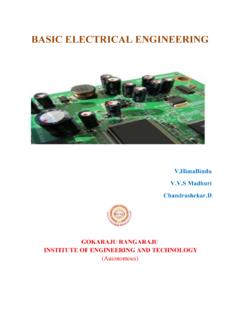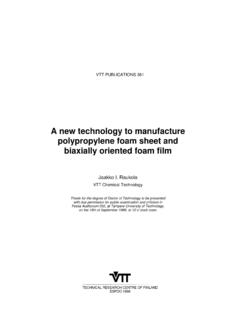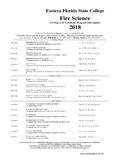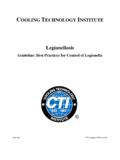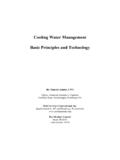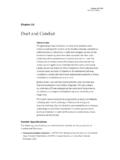Transcription of Gokaraju Rangaraju Institute of Engineering and Technology ...
1 1 Gokaraju Rangaraju Institute of Engineering and Technology ( autonomous ) unit -I : WATER Technology Introduction: Water is nature s most wonderful, abundant, useful compound and is an essential without it one cannot survive. It occupies a unique position in industries. Its most important use is as an Engineering material in the steam generation. Water is also used as coolant in power and chemical plants. It is also used in other fields such as production of steel, rayon, paper, atomic energy, textiles, chemicals, ice and for air-conditioning, drinking, bathing, sanitary, washing, irrigation, etc. Occurrence: Water is widely distributed in nature.
2 It has been estimated that about 75% matter on earth s surface consists of water. The body of human being consists of about 60% of water. Plants, fruits and vegetables contain 90-95% of water. Sources of Water: Different sources of water are: 1. Surface Waters: Rain water (purest form of natural water), River water, Lake Water, Sea water (most impure form of natural water). 2. Underground Waters: Spring and Well water. Underground waters have high organic impurity. 1Q. Explain why hard water does not lather with soap? (Or) What is the cause of hardness of water? (Or) Write short notes on hardness of water. (Or) What is hardness of water due to? Hardness:- Hardness of water is a characteristic property by which water prevents lathering of soap.
3 Causes: The hardness of water is due to presence of certain salts (mainly bicarbonates, sulphates and Chlorides) of Ca, Mg and few other heavy metal salts dissolved in water. 2 A sample of hard water when treated with soap (sodium or potassium salt of higher fatty acid like oleic, palmitic or stearic) do not produce lather with soap, but on the other hand forms a white scum or precipitate. The precipitate is formed due to insoluble soaps of Ca and Mg. Reactions:- 2C17H35 COONa + CaCl2 Ca(C17H35 COO)2 + NaCl Sodium Stearate (Sodium soap) hardness Calcium Stearate (Insoluble) 2 C17H35 COONa + MgSO4 (C17H35 COO)2Mg + Na2SO4 Magnesium Stearate (Insoluble) Thus the water which does not produce lather with soap solution readily is called HARD WATER and water which lathers easily on shaking with soap solution is called SOFT WATER.
4 2Q. Distinguish between temporary and permanent hardness of water? (Or) What is meant by carbonate and non-carbonate hardness of water? (JNTU) Types of hardness: 1. Temporary or carbonate hardness:- It is caused by the presence of dissolved bicarbonates of Ca, Mg and other heavy metals and carbonate of Iron. Temporary hardness is mostly destroyed by mere boiling of water , when bicarbonates are decomposed, they yield insoluble carbonates or hydroxides, which are deposited as crust at the bottom of the vessel. Reactions:- Heat Ca(HCO3)2 CaCO3 + H2O + CO2 (Insoluble) Heat Mg (HCO3)2 Mg(OH)2 + 2CO2 (Insoluble) 2.
5 PERMANENT or NONCARBONATE HARDNESS:- It is due to presence of chlorides and sulphates of Ca, Mg, Fe and other heavy metals. It is not destroyed upon boiling. 3 It can be eliminated by different techniques like, Lime Soda process, Ion exchange process, Zeolite process, etc. Total Hardness= Temporary Hardness + Permanent Hardness. 3Q. How do you express the hardness? What are the units to express the hardness? Or How is the hardness of water expressed? Equivalents of CaCO3:- The concentrations of hardness as well as non-hardness constituting ions are usually expressed in terms of equivalent amount of CaCO3.
6 The choice of CaCO3 in particular is due to its molecular weight 100 (equivalent weight=50) and it is the most insoluble salt that can be precipitated in water treatment. Hardness of the hardness causing salt in terms of CaCO3 The equivalents of CaCO3 = Calculation of equivalents of CaCO3: Salt/ion Molar mass Chemical Equivalent Or Equivalent Weight Multiplication factor for converting into equivalents of CaCO3 Ca(HCO3)2 162 81 100/162 Mg(HCO3)2 146 73 100/146 CaSO4 136 68 100/136 CaCl2 111 100/111 MgSO4 120 60 100/120 MgCl2 95 100/95 CaCO3 100 50 100/100 MgCO3 84 42 100/84 CO2 44 22 100/44 Ca(NO3)2 164 82 100/164 Mg(NO3)2 148 74 100/148 HCO3- 61 61 100/122 OH- 17 17 100/34 CO32- 60 30 100/60 NaAlO2 82 82 100/164 Al2(SO4)3 342 57 100/114 278 139 100/278 H+ 1 1 100/2 HCl 1 100/73 = 4 Units of hardness:- 1.
7 Parts Per Million (ppm):- is the parts of CaCO3 equivalent hardness per 106 parts of water , 1ppm= 1 part of CaCO3 equivalent hardness in 106 parts of water. 2. Milligrams Per Litre (mg/L):- number of milligrams of CaCO3 equivalent hardness present per liter of water. 1mg/L=1mg of CaCO3 equivalent hardness of 1L of water= 1kg=1000g=106mg. 1mg/L=1mg of CaCO3 eq per 106 mg of water=1ppm. 3. Clarke s degree (0Cl):- the no. of grains (1/7000lb) of CaCO3 equivalent hardness per gallon (10lb) of water or it is parts of CaCO3 equivalent hardness per 70,000 parts of water. 1 0Cl= 1 grain of CaCO3 eq hardness per gallon of water = 1 part of CaCO3 hardness eq per 105 parts of water. 4. Degree French (oFr):- parts of CaCO3 equivalent hardness per 105 parts of water.
8 10 Fr= 1 part of CaCO3 equivalent hardness per 105 parts of water. 5. Milli-equivalent per liter (meq/L):- is the number of milli-equivalents of hardness present per liter. 1meq/L= 1meq of CaCO3 per liter of water = 10-3x 50 g of CaCO3 eq. per liter = 50 mg of CaCO3 eq. per liter = 50 mg/L of CaCO3 eq. = 50ppm. Relationship between various units of hardness: 1 ppm = 1 mg/L = Fr = oCl = meq/L 1 mg/L = 1 ppm = oFr = oCl = meq/L 1 oCl = oFr = ppm = mg/L = 1 oFr = 10 ppm = 10 mg/L = oCl = meq/L 1 meq/L = 50 mg/L = 50 ppm = 5 oFr = oCl 4Q. How do you estimate the total hardness of water? Or Explain any one method for the estimation of hardness of water.
9 Or What is the principle of EDTA method? Explain the estimation of hardness of water by complexometric method. Estimation of temporary and permanent hardness:- a) EDTA(Ethylene Di amine Tetra Acetic acid) Method:- 5 Principle: This is a complexometric method. It is in the form of its sodium salt which yields the anion and this forms complex with Ca+2 and Mg+2 ions. (Molecular Wt. - , Equivalent Wt. - , M=2N) In order to determine the equivalence point ( , just completion of metal-EDTA complex formation) indicator Eriochrome Black-T (EBT) an alcoholic solution of blue dye is employed which forms an unstable wine red complex with Ca+2 and Mg+2 ions.
10 The indicator is effective at about pH 10. When EBT is added to hard water, buffered to a pH of about 10 (employing NH4OH-NH4Cl buffer), a wine red unstable complex is formed. Thus, pH =10 M2+ + EBT [M-EBT] complex (M+2= Ca+2 or Mg+2) (Unstable wine red) During the course of titration against EDTA solution, EDTA combines with M+2 (or Ca+2 or Mg+2) ions from stable complex M-EDTA and releasing free EBT, which instantaneously combines with M+2 ions still present in the solution, thereby wine red color is retained. Thus, titration [M-EBT] complex + EDTA [M-EDTA] complex + EBT Wine red (stable complex) (blue) M+2 + EBT [M-EBT] (Ca+2 or Mg+2 still present) (blue) wine red complex When nearly all M+2 (Ca+2 or Mg+2) ions have formed [M-EDTA] complex, then next drop of EDTA added drop wise displace the EBT indicator from [M-EBT] complex and wine red color changes to blue color (due to EBT).
